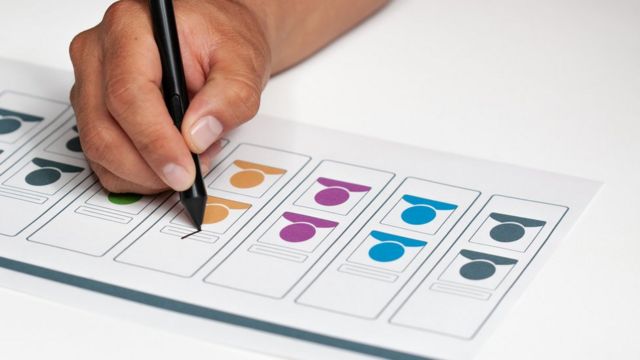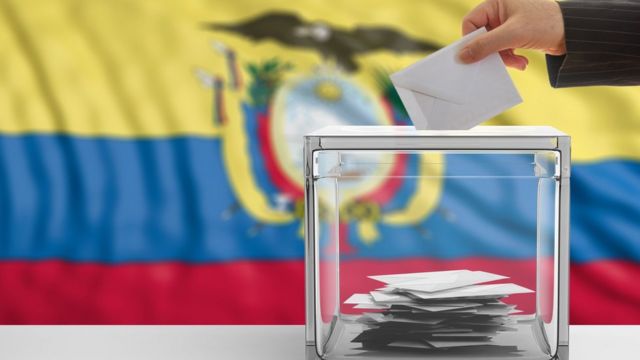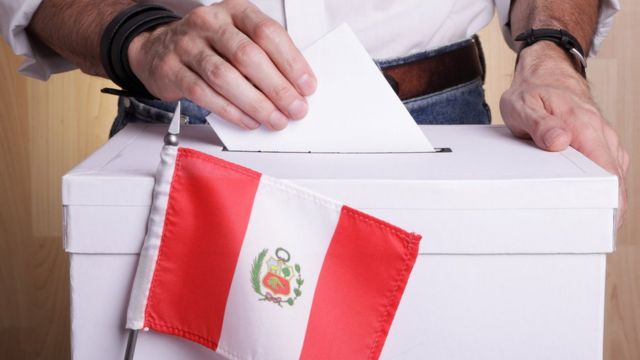Ecuador and Peru: what to expect from Sunday's elections in two countries devastated by the pandemic
This April 11, Peru and Ecuador go to the polls to choose the president in the first and second rounds, respectively
This Sunday (11/04), voters from Ecuador and Peru will go to the polls to elect their presidents amid a set of crises that were intensified during the coronavirus pandemic.
As in other Latin American countries, in the two Andean countries, the sharp drop in the economy worsened the situation of poverty and social exclusion and highlighted the precariousness of health systems.
The situation contributed to the apathy and vagueness of the electorate. The dramatic scenes of people dying on the streets of Ecuadorian Guayaquil and the endless lines to buy oxygen tubes at the parallel market in the Peruvian capital, Lima, last year, are still in the memory and among the fears of the inhabitants of both countries - which they also still face high covid-19 records.
In the past few days, however, the lines were still shorter than before. "Those who can buy the tubes as a precaution and leave them at home. When a family member suffers the disease, they call a private doctor to control the measurements of the tube and thus avoid having to go to a hospital where the situation is chaotic", he says. a Peruvian economist residing in Lima. Many people still do not know if they will vote and will only decide at the last minute for fear of being infected. Voting is mandatory, but the fine of around 88 soles (about $ 20) is assessed as an option by those who can pay it.
Political analyst Alfredo Torres, executive president of Ipsos-Peru, told BBC News Brasil that the pandemic situation "has generated a lot of irritation" in the population with the health system "that doesn't work" and the lack of vaccines. And the situation, says Torres, is reflected in the "historical fragmentation" planned for this Sunday's election.
To top it off, Ecuador has already been its fifth Minister of Health since the beginning of the pandemic and, in Peru, a scavenger-queue scandal against the covid-19 caused, in February, the departure of the ministers of Health and Foreign Affairs of the government of Francisco Sagasti - fourth successor to assume the Presidency since the fall of President Pedro Pablo Kuczynski, PPK, and after the Vice President, Martín Vizcarra and the President of the Congress of the Republic Manuel Merino.
The political wear and tear of current leaders in Ecuador and Peru is another factor in this election, as noted by analysts and observers heard by BBC News Brasil.
"(Ecuadorian) President Lenín Moreno generated distrust in the sectors linked to former President Rafael Correa when he broke off his relationship with him. But Moreno's decision to break up with Correa also ended up generating distrust of him in other political forces. He is today the least popular president since the return of democracy in 1979, "said political scientist Simón Pachano, a professor at the Latin American Faculty of Social Sciences (Flacso) in Ecuador.
Pachano added that it was not clear who could be the winner since Sunday. "People were already discouraged by Lenín Moreno's economy and performance, and the pandemic added more discouragement to voters," he said.
It is in this political environment that Ecuadorians will vote in the second round among candidates who are seen as opposite extremes due to their trajectories and the proposals they presented during the electoral campaign.
The presidential candidates Andrés Arauz, who defines himself on the left, is from Fuerza Compromiso Social (Força Compromisso Social) and was a minister in the Correa government. Conservative businessman Guillermo Lasso is opposed to initiatives such as same-sex marriage and in the final stretch of the campaign he said, however, that he would rule for everyone, as noted by Pachano.
Political wear and tear on current leaders in Ecuador and Peru is a major factor in this election, say analysts and observers heard by BBC News Brasil
Arauz is the candidate of ex-president Correa, who ruled Ecuador for ten years, between 2007 and 2017, and today lives in Belgium (in exile, in the words of opponents, since he was sentenced to eight years in prison for accusations of corruption in your country). In the first round of the election, in February, Arauz, 36, was the most voted, with 32.7%. Lasso received 19.74% of the votes with a slight difference to the third candidate, Yaku Pérez, from the Pachakutik indigenous movement, after a poll that lasted several days.
Of the polls released before the election, five indicated Arauz as the winner and four indicated that it would be Lasso.
With a population of around 17.3 million inhabitants and approximately 13 million voters, Ecuador registers 32% of the poor, according to official data. The country where the currency is the dollar recorded a 7.5% drop in its economy in 2020, according to the International Monetary Fund (IMF).
For this year, the organization predicts that the country will register a recovery of only 2.5%, according to the newspaper El Comercio, from Quito. The economic situation, including the maintenance or not of the dollar, and the possible return of Correa to the country, if Arauz is elected, were part of the political discussions in the final stretch of the campaign, in which the candidates appeared almost all the time wearing masks as prevention against the coronavirus.
Six of Peru's 18 candidates stand a chance of reaching the second round of the toughest election in recent years
Fragmentation and 'Peruvian Bolsonaro'
In neighboring Peru, political fragmentation is such that the race in this first round includes a list of 18 presidential candidates.
In both cases, there is caution among analysts about the result, although in Peru, the expectation is that the second round will be held on June 6.
"Here everyone seems to be an opponent and the governing candidate (Julio Guzmán) appears with little chance," said an observer behind the scenes of local politics.
Of the 18 candidates, 6 of them would have the chance to reach the second round - among them the daughter of ex-president Alberto Fujimori and ex-presidential candidate Keiko Fujimori who is running the race for the third time.
In the previous campaign, she avoided the figure of her father, imprisoned. In this, the candidate shows closeness with the politician who ruled the country for ten years between 1990 and 2000. She started to defend "la mano dura" (hard hand) against crime, arousing support from old and new Fujimorist voters, according to local observers.
Among the other candidates that have stood out in recent days are Pedro Castillo, from the left Peru Libre, Verónila Mendoza, from the left Juntos por el Perú, Hernando de Soto, from the right, from Avanza País, Yonhy Lescano, from the traditional Acción Popular, and the millionaire and ultraconservative Rafael López Aliaga, from Renovación Popular.
In the political sphere and in the local press, López Aliaga is called "Peruvian Bolsonaro" for his aggressive speech, for having built his base with the support of religious people and for not defending, for example, the use of a mask against the covid. "Bolsonaro from Peru running for election," replied the Buenos Aires-based newspaper Página 12, from the Peruvian press.
"This is the most fragmented election in our history and, at the same time, very polarized between the extremes of the right and the left. Those in the center have not obtained support," said Torres.
"With more than 30% undecided or who have already declared that they will vote blank or null, any result is expected for this Sunday. The only certainty we have is that there will be a second round," says Professor Carlos Aquino, from the National University of San Mayor Marco (UNMSM), from Lima.
The volatility of the Peruvian voters' intention to vote has already put Lescano ahead with just 10% of the vote intentions and minimal differences for the other candidates in the survey conducted by Ipsos for Lima's El Comercio newspaper, published on April 4. But hours before the vote, the picture looked different and analysts did not rule out that the winners of this first round would be - "the opposite ends - Keiko and Castillo.
In the debates, in addition to the pandemic and the economy, themes related to Brazil emerged, such as scandals involving Brazilian contractors such as Odebrecht, which were linked to the arrests of three presidents and the suicide of former president Alan García.
A country with just over 32 million inhabitants and almost 25 million voters, Peru showed in the pandemic that its macroeconomic performance, with stability and steady growth in recent years and that it was considered one of the models in the region, has not been transferred to the population well-being, despite the sharp drop in poverty it had recently registered, according to local analysts.
Poverty had fallen dramatically in the past decade, but with about 74% of workers in the informal economy, and hospitals unprepared and lacking beds and oxygen for their patients, Peru was the scene of some of the most dramatic global health collapse scenes in the first months of the pandemic. Despite the closing of borders to try to prevent the expansion of the virus's arrival in the country, workers continued to leave to work - "because they have no other option since informality is dominant in the country", said Professor Carlos Aquino, from the National University Mayor of San Marco (UNMSM), of Lima.
According to the Economic Commission for Latin America and the Caribbean (ECLAC), the Peruvian economy shrank by almost 13% in 2020, but is expected to register a strong recovery of approximately 9% in 2021. However, 7 out of 10 Peruvians are today considered poor or can enter in poverty in the face of his fragile economic situation, according to the daily Gestión, from Lima.
This Sunday, in addition to voting for president, Peruvians are voting to elect congressmen from Parliament, which is unicameral. The expectation is for fragmentation also in the house.




No comments:
Post a Comment